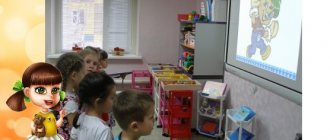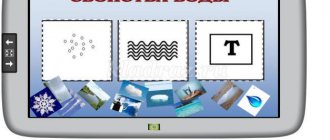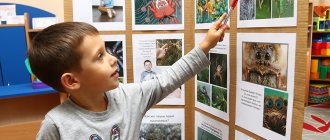Basic conditions for conducting classes in preschool educational institutions and interactive teaching methods
- correct definition of the topic of the lesson, careful selection of program content and tasks;
- inclusion of children’s previous experience in the educational process (using the apperception method);
- a thoughtful combination of individual and group forms of work with children, changing the types of activities of preschoolers;
- the use of interactive teaching methods, activation of children’s mental activity at all stages of the lesson;
- the presence of high professional qualities of the teacher, which will ensure creative cooperation and interaction;
- the presence of a meaningful game-based subject-development environment, rich didactic material;
- mandatory consideration of the age and individual characteristics of children, their creative abilities.
Interactive technologies in teaching preschoolers
Interactive technology means to interact, communicate with someone; This is a special form of organizing cognitive and communicative activities in which all participants are covered by communication (everyone freely interacts with everyone else, participates in an equal discussion of the problem).
Interactivity develops responsibility and self-criticism in a child, develops a creative approach to solving problems, teaches him to correctly and adequately assess his strengths, and see “blank spots” in his knowledge. The main element of an interactive lesson is dialogue.
During interactive learning, children actively communicate, argue, disagree with the interlocutor, and prove their opinion.
One of the main conditions for conducting classes in preschool educational institutions is the use of interactive teaching methods, activating the mental activity of children at all stages of the lesson.
Individual training events
- Survey
It is best to use a survey at the end of the lesson. Ask students to write an answer to a specific question within one minute. For example: “What is the most important thing you learned today?”
Then you can start the conversation from there in the next lesson. You can ask students if they still remember what they wrote down.
- Checking for misconception
Identify student misconceptions. See if they can identify the correct answer when given a false fact. This is useful for reinforcing the previous lesson and also encourages students to think deeply and retain the material better.
- Circle the question
Create a checklist or survey with a list of questions (make them specific) about your topic and ask students to circle (or mark) the ones they don't know the answer to.
Create assignments based on the different questions that have been circled. Have your students work on additional exercises and explanations for these assignments individually. Since your students will all circle different questions, you should give each of them their own individual set of tasks.
OPEN AN ONLINE SCHOOL ON THE ANTI-TRAINING PLATFORM
- Ask the "A" student
Ask students to silently solve a problem or answer a question. After receiving an answer, ask those who did it correctly to raise their hands (if the lesson is taking place offline) or write about it in the chat (if you are teaching an online lesson). Then all other students should talk to someone who completed the task in order to better understand the essence and avoid making mistakes next time.
Interactive methods of teaching and interacting with children
Interactive teaching methods are ways of targeted interaction between adults and children that provide optimal conditions for their development.
Interactive learning for preschoolers is a specific form of organizing educational activities, the purpose of which is to provide comfortable conditions for interaction in which each child feels his success and, by performing certain intellectual work, achieves high productivity.
Interactive teaching methods provide such learning that enables children in pairs, microgroups or small groups to work through educational material, talking, arguing and discussing different points of view.
Interactive methods of teaching and developing speech for preschoolers
Microphone is a method of work during which children, together with the teacher, form a circle and, passing an imitated or toy microphone to each other, express their thoughts on a given topic.
For example, a child takes a microphone, talks about himself in a few sentences, and passes the microphone to another child.
All statements made by children are accepted and approved, but not discussed.
Debate is a method of work during which children stand in a circle, express their thoughts on a given topic, passing the microphone to each other, but the statements are discussed: children ask each other questions, answer them, looking for a way to solve the problem.
(For example, Seryozha is in a bad mood, so the children suggest ways to cheer up or eliminate the problem that affected the boy’s mood).
Together - a method of work during which children form working pairs and complete the proposed task, for example, take turns describing a picture.
Chaining is a method of working in which children discuss tasks and make suggestions in a simulated chain. For example, they compose a fairy tale according to a table in which the course of the future fairy tale is presented in drawings or in symbols.
Another option for using this method: the first child names an object, the second - its property, the third - an object with the same properties.
For example, carrots - carrots are sweet - sugar is sweet - sugar is white - snow is white... etc.
Snowball is a method of work during which children unite in small groups and discuss a problematic issue or complete a common task, agreeing on a clear sequence of actions for each group member.
For example, they are building a house, where they agree in advance on the order of actions of each team member and on the color with which this or that child will work.
Synthesis of thoughts is a method of work in which children are united in small groups to complete a specific task, for example, drawing on a piece of paper.
When one group draws, it passes the drawing to another group, whose members finalize the completed task. Upon completion of the work, they write a general story about what they completed and why.
Circle of ideas - interactive teaching methods, when each child or each group performs one task, for example, composing a fairy tale in a new way, discussing it, then making suggestions or ideas (for example, how can we finish the fairy tale so that Kolobok remains alive; how to help Kolobok outwit the fox and the like).
A common project is a method of work during which children are united into several groups (3-4).
Groups are given different tasks, each aimed at solving a different aspect of one problem, for example, drawing their favorite winter activities and talking about them.
Each group presents its “project” - the collective work “Winter Fun” and discusses it together.
Associative flower is a method of work in which children are united in several groups to solve a common problem: the “middle” of a flower with the image of a certain concept is fixed on the board, for example, “toys”, “flowers”, “fruits”, “animals”.
Each group selects association words or association pictures that are pasted around this concept. The team that creates the largest flower (with the largest number of selected association pictures or association words) wins.
“Decision tree” is a method of work that includes several stages:
- Choosing a problem that does not have a clear solution, for example, “What does a tree need to be happy?”
- Consideration of a diagram in which the rectangle is the “trunk” (which denotes this problem), the straight lines are the “branches” (the ways to solve it), and the circles are the “leaves” (the solution to the problem).
- Problem solving: children in subgroups agree, discuss and draw, for example, a butterfly, a bird, etc., placing them on a “decision tree” and explaining their choice.
The method of multichannel activity is a method of working with children, during which various analyzers are necessarily used: vision, hearing, touch, taste, smell.
For example, when viewing a painting, it is advisable to use the following sequence: highlighting the objects depicted in the painting; representation of objects through perception by various analyzers.
After considering all the objects depicted in the picture, it is worth setting the children creative tasks:
- “listen” to the sounds of the picture through “headphones”;
- conduct virtual dialogues on behalf of the depicted characters;
- feel the “aroma” of the flowers depicted in the picture;
- “go beyond what is depicted”;
- mentally touch the picture, determine what its surface is (warm, cold), what the weather is like (windy, rainy, sunny, hot, frosty) and the like.
For example, when looking at the painting “A Walk in the Woods,” you might want to ask the following questions: What do you think the girls are talking about? Look at the bark of the trees, what is it like?
Listen to the sounds of leaves rustling, magpie chirping, etc.
Discussion is a method of collective discussion of a complex issue. All participants in the educational process prepare for the discussion; all children are actively involved.
“Discussion” in English is something that is subject to discussion or debate.
At the end of the discussion, a single collective solution to a problem, problem or recommendation is formulated. No more than five questions (tasks) should be proposed.
They should be formulated in such a way that it is possible to express different views regarding the problem raised.
Children learn to express their own opinions: “I think...”, “I believe...”, “In my opinion...”, “I agree, but...”, “I disagree because...”.
“Brain attack (brainstorming)” is one of the methods that promotes the development of creativity in both children and adults. This method is convenient to use when discussing complex problems or issues.
Time is given for individual reflection on the problem (it can even be up to 10 minutes), and after some time additional information is collected regarding decision-making.
Children participating in a brainstorming session must express all possible (and logically impossible) options for solving a problem, which must be listened to and the only correct decision made.
Quiz is a method-cognitive game that consists of speech tasks and answers to topics from various branches of knowledge. It expands the general cognitive and speech development of children. Questions are selected taking into account the age, program requirements and level of knowledge of the children.
Conversation-dialogue is a method aimed at the participation of children with the speaker. During the lesson, with the presentation of knowledge and consolidation of the material, the teacher poses accompanying questions to the children in order to check their understanding of the information presented.
Modeling problem situations is a method of interaction between adults and children to solve a problem. The situation is specifically modeled by the teacher.
"What? Where? When?" - an active method, during the use of which cooperation, creative problem solving, mutual exchange of opinions, personal knowledge and skills, etc. predominate.
“Pros and cons” is a method of working with children, during which children are asked to solve a problem from two sides: pros and cons. For example, the task is to tell why you like winter (the argument is “for”) and why you don’t like winter (the argument is “against”).
Foresight is a method of working with children, during which it is proposed to “predict” possible solutions to a problem.
For example, invite children to name all the autumn months and talk about what they expect from each month. Later, imagine yourself in the place of one of the months and tell about your predictions: “I am the first month of autumn - September. I am a very warm month. All the children love me because they are starting to go to school...”
The next child continues to talk about this very month (work in pairs).
Showing off is a method of work in which children are asked to divide into teams, each of which thinks of a word and, using non-verbal means, presents this word to the other team, which must guess it.
“What would happen if...?” - a method of work in which children are invited to think and express their assumptions, for example: “What would happen if all the trees on Earth disappeared?”, “What would happen if predatory animals in fairy tales became vegetarians?” etc.
Imaginary picture is a method of work in which children are asked to stand in a circle and each child takes turns describing an imaginary picture (the first child is given a blank sheet of paper with a picture drawn, then he passes the sheet with the mental picture to another participant in the game, and he continues the mental description ).
“What can you do...?” - a method of work during which children learn to understand the multifunctional properties of objects. For example: “Imagine another way to use a pencil? (like a pointer, baton, thermometer, baton, etc.).
Reincarnation is an interactive teaching method when children are invited to divide into teams and imagine themselves in the place of some object (book, pen, table, doll, etc.) and present themselves from the point of view of the chosen role.
A reverse fairy tale is a method of work in which children are asked to divide into two teams and compose their fairy tale differently, replacing basic concepts with opposite ones. Each team receives a task: composes its own fairy tale and guesses the fairy tale of the other team, composed differently.
Example: “Once upon a time there lived a grandfather and a woman. And they had a dog, Zhuk. And the Beetle brought them a bone, not a simple one, but a sugar one. Baba cooked it, cooked it, and didn’t cook it. Grandfather cooked and cooked and did not cook. The cat jumped, overturned the pot, took the bone and carried it away. The grandfather laughs, the woman laughs, and the Beetle barks cheerfully: “I’ll bring you another bone, but not a sugar one, but a plain one, so that it can be cooked quickly.”
Collage is a method of work in which children are asked to divide into two teams and complete their picture (for example, an irregularly shaped figure) on a piece of paper with all available materials and talk about it in 2-3 sentences.
- a method of work during which children are asked to divide into two teams, each of which chooses any object and tries to name all its positive qualities and functions that will help attract the attention of others to it.
Activity in pairs
- Find a couple and share
After the sharing and discussion described in the first idea above, you can also ask students to find a new partner and share with them the learnings and realizations that occurred in a previous partnership with another student.
- Teacher and pupil
Invite students to discuss the main points of the lesson. Then divide students into pairs and assign them 2 roles. One of them is a teacher, and the other is a student. The teacher's job is to jot down the main points, while the student's job is to cross off items on his list as they are mentioned and come up with 2-3 items that the teacher missed.
- Share your partner's results
After individual creative activity, pair students to share their results. Then give the floor to volunteers who found their partner's work interesting or exemplary. Students are often more willing to publicly share fellow students' work than their own. As a result, you can gently lead them to share their findings and perhaps even the results of their work.
- Forced dispute
Have students discuss in pairs. They must defend the opposite side of their personal opinion. This encourages students to step away from their own beliefs and teaches them to look at a situation from a different angle from time to time.
There may be this option: one half of the group takes one position, the other half another. Each person can speak only once so that all students on both sides can speak about the issue.
- Optimist/pessimist
In pairs, students consider opposing emotional sides of a case study, statement, or topic. Ask them to truly “live” the case study. You'll discover some good ideas and your students will gain important social skills.
- Expert review
To help students with a writing task, have them exchange drafts with a partner. The partner reads the essay and writes a 3-paragraph response: the first paragraph describes the strengths of the essay, the second paragraph discusses its problems, and the third paragraph describes what the partner would focus on in editing if it were their essay. Students can learn a lot from each other!
Other interactive teaching methods
In addition to the above-mentioned interactive methods of teaching preschoolers, the following are actively used in practice: creative tasks, work in small groups, educational games (role-playing and business games, simulation games, competition games (senior preschool age), intellectual warm-ups, work with visual videos and audio materials, thematic dialogues, analysis of life situations and the like.
Thus, interactive learning in classes (including integrated ones) takes place: in pairs (2 children), in microgroups (3-4 children), in small groups (5-6 children) together with the teacher.
When evaluating children’s statements, you should not use the word “correct”, but say: “interesting”, “unusual”, “good”, “wonderful”, “original”, which stimulates children to make further statements.
Worth remembering! When a preschool child sits politely on a chair, looks at you and just listens, he is not learning.
Group activities
- Movement from board to board
Divide the group into several subgroups of students and give them your own board (flipchart or interactive, depending on whether you teach offline or online). Distribute one question/topic per board. After the group writes the answer on the board, they move to the next board. Here they write their answer under the answer of the previous group. Continue this way until all groups have written their answer on each board.
- Winner selection
Divide the group into subgroups and give them the opportunity to work on one topic/problem. Have them write down the answer/strategy on paper or digitally. Then ask the subgroup to interact with the subgroup closest to them and allow their answer to be judged. And do this with each subgroup until everyone evaluates each other. Then all subgroups must unite into 1 and choose the best answer from the two options, which will be presented to the whole group.
- Movie app
In groups, students discuss examples of films that use the concept or event discussed in class, trying to identify at least one way the filmmakers got it right and one way they got it wrong. Think about films showing historical and geographical facts, biographies of famous people, etc.
Insufficient use of interactive methods
Unfortunately, interactive teaching methods are not yet used enough in working with preschoolers. There are some reasons for this (according to A. Kononko):
- the habit of many educators to use explanatory, illustrative, monological methods in their work, to show conformism, to unquestioningly obey the requirements and principles of others;
- distrust of a certain part of teachers towards innovative dialogue methods and their fears;
- lack of experience in their effective use, active self-determination, making responsible decisions, providing advantages to someone (something);
- fear of looking like a “black sheep” in the eyes of others, funny, helpless, inept;
- low self-esteem, excessive anxiety of teachers;
- tendency to be overly critical;
- inability to quickly switch and adapt to new conditions and requirements;
- lack of formation of pedagogical reflection, the ability to objectively evaluate oneself, to correlate one’s capabilities and desires with the requirements of the time.
The need to introduce interactive methods into the educational process is obvious, because:
- today, more than ever, the requirements for updating preschool education for pupils are increasing;
- differentiation and individualization of education for preschool children occurs;
- The requirements for the quality of preschool education are changing, its assessment is not only based on the level of knowledge readiness, but also the elementary life competence of preschool educational institution graduates, their ability to apply knowledge in their own lives, constantly update and enrich it.




